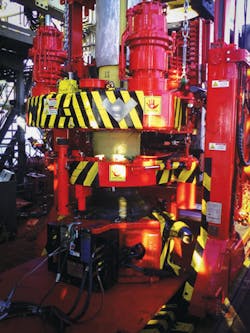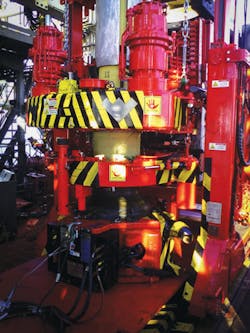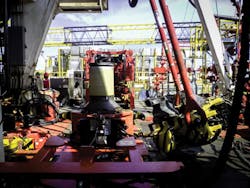Customized riser installation enhances safety, efficiency for multi-well deepwater project
Byron Chang
Weatherford
The risks, costs, and technical complexities of deepwater development often require customized solutions that assure safety and boost field economics by employing life-of-well systems. All aspects of well construction, including rig design, riser installation, pipe-handling and connection makeup and integrity, must be implemented with a level of precision and service quality that will enable the wells to produce safely for 30 or more years.
For a multi-well deepwater project in Southeast Asia, a major operator engineered a unique tension-leg platform (TLP) with 24 slots for eventual batch drilling. The vertically moored floating platform moves laterally with changing weather and ocean conditions, and is well suited for the project’s 1,640-ft (500-m) water depth. TLPs typically use a top-tension riser (TTR) that runs between the platform and seabed. The riser is securely connected to the wellhead with an external tieback connector and remains in place for the life of the well.
For this project, the operator deployed a specially designed TTR that could be used for both drilling and production. Unlike conventional systems that use separate risers for drilling and production, the single-casing combination (SCC) TTR uses the same outer riser for drilling, completion, production, and workover operations. This approach enables the operator to eliminate the time and cost of installing two sets of risers, and streamlines drilling.
In a first-of-its-kind installation, Weatherford engineered a fit-for-purpose tubular handling and makeup package for the multi-use riser. The integrated, customized solution, which was designed for use on 11 platform wells, combines several tubular running technologies and tools that are specially designed to handle non-API sizes of pipe. As a whole, the package is able to transport the 40-ft (12-m) long TTR joints from the rig floor; monitor and evaluate torque data for safe, efficient makeup and breakout of the 40 high-delta torque connections required for each well; and run the pipe inside the rotary table - all with the least possible disruption to the existing rig equipment.
Deploying a highly robust, mechanized riser power tong onto the rig was essential to enable safe and efficient makeup and breakout of high-torque connections that far exceed the standard 100,000 ft-lbs of torque provided by conventional power tongs. Weatherford’s global and regional engineering teams collaborated closely with the operator for more than a year to ensure that the riser installation met or exceeded the highest industry standards. In preparation for the initial riser installation on the first platform well in October 2016, a qualification test in August 2015 demonstrated that the system could reliably achieve the required delta torque connections.
High-torque connections
The cornerstone technology of the ongoing riser installation project is the Weatherford 21-300 riser tong, designed specifically to handle delta torque connections as well as to provide continuous rotation throughout the makeup cycle. For the initial job, final makeup torques reached as high as 110,000 ft-lbs, and final breakout torques reached up to 235,000 ft-lbs. While most operations do not require these high levels of torque, the 21-300 riser tong is capable of meeting such rare client challenges, especially in the Eastern Hemisphere.
The 7-ton mechanized tong can produce up to 300,000 ft-lbs of continuous rotational torque during both the makeup and breakout processes - considerably higher than what conventional systems provide. It can be used in any riser installation, handling sizes ranging from a 9-in. to 21-in. OD. In this specific application, the tong was configured according to the acceptance criteria for the non-standard 18.149-in. OD delta torque connection.
Rig-up of the tong can be completed using conventional procedures without modifications to the rig. The tong is also capable of both fully mechanized remote operations and semi-mechanized operations. The three-motor design distributes force evenly around the gear ring, improving gripping effectiveness to decrease the risk of pipe damage.
A hydraulic, three-jaw gripping system provides extremely high torque capability and distributed gripping forces over a large area, which reduces the potential for connection damage. Most importantly for long-term wellbore integrity, the tong is compatible with torque monitoring, control and analysis hardware and software, which enables automated recording of delta turns and torque.
To precisely position the heavy riser tong, another robust mechanized system comes into play. The PowerFrame II tong-positioning system is remotely operated to eliminate the need for manual handling by the crew, thereby enhancing safety and reducing operating costs. The tong-positioning system uses wheels for horizontal movement on the rails and two hydraulic lift cylinders for vertical lifting of the gantry. With a maximum lifting stroke of 77 in., the system accelerates the lifting and positioning process.
The plug-and-play design of the system enables quick and efficient tong change-out, further reducing time and cost. The system is track-mounted and uses programmable logic control technology to move a full range of Weatherford power tongs from a standby position on the rig floor to the well center.
Customized tubular handling
To install the tong, the service provider uses the HiPer control system to remotely control the power tong and tong-positioning system. This eliminates the need for an additional control system, further reducing operational cost and complexity. Multiple safety features, including emergency shutdowns and interlocks, decrease the risk of accidents and injuries.
For this particular TLP, the tubular handling package includes two automated side door (ASD) elevators, an automated false rotary system, and a stress joint handling elevator. Each component was customized to accommodate the non-standard outer diameter of the riser and avoid any marking or damage to the thermal sprayed aluminum coating on the riser and pipe joints. The coating is designed to assure well integrity by preventing the pipe from deteriorating or rusting over the 20- to 30-year life of the well.
The hydraulically operated ASD elevators, with bushings to suit non-API sizes and the non-marking requirement, are API 8C certified for lifting and hoisting large outer diameter casing strings. The two elevators are interlocked to prevent both elevators from being opened at the same time, thus mitigating the risk of a dropped string.
The automated false rotary table (AFRT) allows the rotary table to fully open to 49.5 in. to enable pass-through of a 48.5-in. OD assembly. The AFRT also allows the ASD elevator, once opened, to disengage from the TTR without the need for manual handling. After disengaging, the ASD elevator is locked into the standby position, which allows the AFRT to close. The second ASD elevator can then land on the closed AFRT, where the bails are removed and installed on the first elevator in standby.
The stress joint elevator (SJE) is used to handle the first connection, which has a weight of 17 tons and a pipe OD of 15.2 in., as well as the subsequent connections with ODs of 14.347 in. and 14.488 in. The SJE also eliminates the need for a special bushing to be installed on the ASD elevator, therefore reducing cost and increasing handling efficiency.
Ensuring connection integrity
One of the most important aspects of the ongoing riser installation operation is ensuring the integrity of the delta torque connections. Connection failures account for an estimated 90% of casing failures, with even one improper connection resulting in operational failure or problems, including shut-ins and lost production. To avoid that risk, connections must be made up properly so that seals withstand high-torque and bending stresses.
As part of the customized installation service, Weatherford combined a torque-turn monitoring system with a powerful analyzing software platform to monitor, evaluate, and report torque data for makeup and breakout of all the delta torque connections. The JAMPro torque-turn monitoring system enables remote monitoring and control of torque-turn data during tubular makeup. The system also provides histograms and trend analysis to enter torque-turn data into the well log for enhanced monitoring.
To qualify the delta torque connections reported in by the JAMPro system, the company deployed the TorkPro 3 torque/turns analyzing software. The TorkPro software enables real-time analysis of the makeup process and evaluates connections for acceptance or rejection, minimizing response times to connection issues.
Results
Using the customized, fit-for-purpose tubular running equipment, the initial riser installation on the TLP was completed in 36 hours. A total of two installations were performed in 2016, enabling the operator to successfully move forward with field development. Lessons learned in rigging up the equipment and positioning the tong have streamlined the process, improving both safety and efficiency. Over a period of 12 months, the TTR installation package will be used to develop nine producer wells and two water-injection wells.





